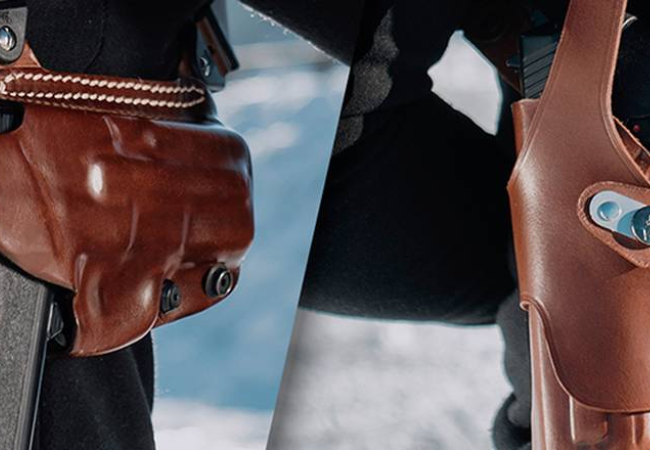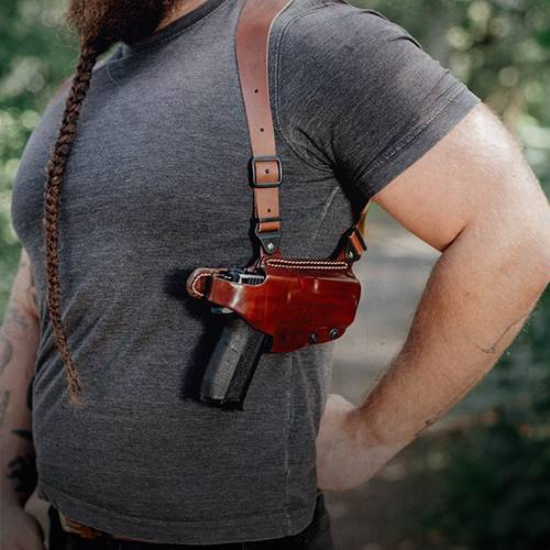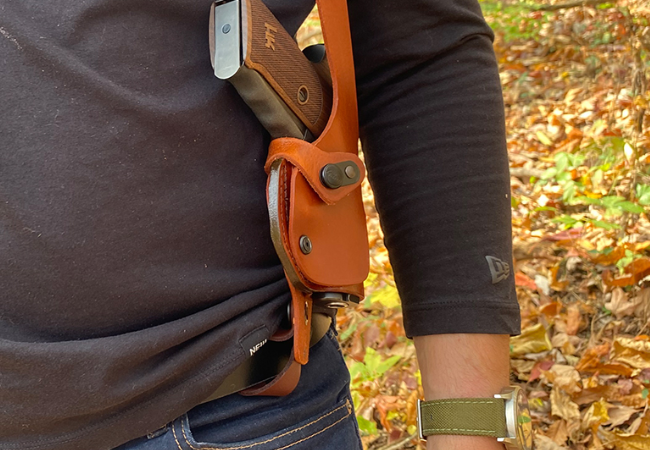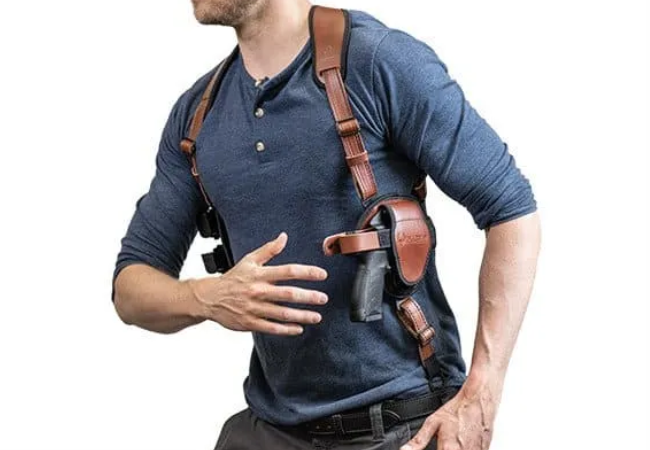Shoulder holsters have been used for centuries by law enforcement, military, and civilian gun owners.

There are primarily two styles of shoulder holsters, vertical and horizontal, each with its advantages and disadvantages.
This article will explore these two types and provide an in-depth comparison.
Vertical Shoulder Holsters
Design and Features
Vertical shoulder holsters hang the gun vertically downward. This design is usually more concealable and provides several benefits to the wearer.
This design makes it distinct from horizontal shoulder holsters and brings about several unique characteristics:

- Alignment: The gun is aligned parallel to the wearer’s body, creating a slim profile that enhances concealment. This alignment minimizes the chance of the gun being detected, especially when the wearer is in motion.
- Construction: Vertical shoulder holsters typically feature a harness that is worn over the shoulders and is adjustable for various body sizes. The holster itself may be constructed from leather, nylon, or other synthetic materials, offering different levels of durability and comfort.
- Attachment Options: Many vertical holsters come with attachments for additional accessories like extra magazines or handcuff pouches. These can be customized based on individual preferences and requirements.
- Retention Systems: Retention is a critical aspect of any holster design, and vertical shoulder holsters often include adjustable retention straps or thumb breaks. This helps to secure the firearm while still allowing for quick access when needed.
- Compatibility: Vertical shoulder holsters are often preferred for carrying larger or longer-barreled handguns. This is due to the way they position the gun, allowing for more room without affecting comfort or concealment.
- Weight Distribution: Since the gun is hanging vertically, the weight is distributed more evenly across the shoulder and back. This minimizes strain and fatigue, particularly when the holster is worn for extended periods.
- Mobility Considerations: The vertical alignment can have an impact on mobility, especially when sitting or bending. However, proper adjustment and fitting can mitigate these issues, offering good freedom of movement in various situations.
The design and features of vertical shoulder holsters are tailored to meet specific needs, such as enhanced concealment, comfort, and compatibility with larger firearms.
The various elements, including alignment, construction, attachments, retention, and weight distribution, contribute to a functional and practical carrying solution for many gun owners.
Whether used by law enforcement, military, or civilians, vertical shoulder holsters offer a unique blend of benefits that set them apart from other holster styles.
Advantages
- Comfort: Vertical shoulder holsters often distribute weight evenly, making them more comfortable for extended wear.
- Concealment: They tend to hide the gun’s outline better than horizontal designs.
- Safety: The muzzle points downwards, reducing the risk of accidental discharge.
- Compatibility: They often accommodate larger handguns, making them versatile.
Disadvantages
- Draw Speed: Retrieving the firearm may be slower compared to horizontal designs.
- Adjustments: It may require more adjustments to fit properly.
- Accessibility: It might not be suitable for all body types.
Horizontal Shoulder Holsters
Design and Features
Horizontal shoulder holsters position the firearm horizontally across the chest. This style is more common and has some unique characteristics.
Horizontal shoulder holsters are distinct in that they hold the firearm in a horizontal orientation, with the barrel pointing parallel to the ground. This orientation provides a unique set of attributes:

- Alignment: Unlike vertical holsters, horizontal shoulder holsters align the gun perpendicular to the wearer’s body. This alignment allows for a quicker draw but might present some challenges in concealment, especially with larger firearms.
- Construction: Similar to vertical holsters, horizontal ones are commonly made from materials like leather, nylon, or synthetics. These materials offer different levels of comfort and durability, depending on individual preferences.
- Attachment Options: Many horizontal holsters come with options to attach additional accessories, such as magazine pouches or other equipment. This allows for personal customization according to specific needs.
- Retention Systems: Security is vital, and horizontal shoulder holsters typically feature adjustable retention mechanisms like thumb breaks or Velcro straps. This ensures that the gun stays securely in place while still allowing quick access when required.
- Compatibility: Horizontal shoulder holsters are often preferred for medium-sized handguns. Larger firearms may protrude more and become uncomfortable or conspicuous.
- Weight Distribution: The horizontal positioning of the gun may impact weight distribution. The gun’s weight may feel more concentrated in one area, and the fit and adjustments must be carefully considered to ensure comfort.
- Mobility Considerations: The horizontal alignment may be more comfortable when sitting or bending over, depending on the gun size and wearer’s body type. However, care must be taken with concealment in these positions.
- Safety Considerations: Since the muzzle points backward, careful consideration must be given to where the barrel is pointing, especially in crowded environments.
- Aesthetics: Horizontal shoulder holsters are often seen as more visually appealing and have been popularized in various films and media. The look and style may be an appealing factor for some wearers.
Horizontal shoulder holsters offer a design that emphasizes quick access and a stylish appearance. They can be an excellent choice for those who prioritize a fast draw and a more aesthetically pleasing look.
However, considerations regarding concealment, compatibility, weight distribution, mobility, and safety must be carefully weighed to find the right horizontal shoulder holster for one’s specific needs.
The blend of practical functionality and visual appeal makes horizontal shoulder holsters a popular choice for many gun owners.
Advantages
- Ease of Access: These holsters allow for a quicker and more natural draw.
- Aesthetics: Often considered more stylish, they are a popular choice in films and media.
- Adjustability: Many designs offer a good degree of customization for fit and comfort.
- Range of Motion: They often allow for better arm movement.
Disadvantages
- Concealment: They may reveal the gun’s outline more easily under clothing.
- Comfort: The weight distribution may be less balanced, leading to discomfort.
- Safety Concerns: The muzzle points backward, potentially at bystanders.
Comparison
Comparing vertical and horizontal shoulder holsters requires examining various facets that cater to different needs and preferences. Below is a detailed comparison to help understand these two distinct designs:
Suitability
Vertical holsters may be better suited for larger guns and those needing more concealment, while horizontal holsters offer quicker access.
- Vertical Holsters: Ideal for larger firearms and for individuals who require greater concealment. They can be suitable for outdoor activities where the handgun’s outline needs to be well-hidden.
- Horizontal Holsters: More fitting for medium-sized handguns and those who prioritize a quicker draw. Suitable for urban environments where accessibility is a key concern.

Comfort and Style
While both types can be comfortable, the vertical holster often wins in concealment, whereas the horizontal design may be more stylish.
- Vertical Holsters: Offer better weight distribution, minimizing strain for prolonged wear. Concealment is often superior, hiding the gun’s outline effectively.
- Horizontal Holsters: May not distribute weight as evenly, leading to potential discomfort. Concealment can be challenging, especially with larger firearms.
Safety Considerations
The direction the muzzle points (downwards for vertical, backwards for horizontal) can influence the choice based on safety considerations.
Vertical Shoulder Holster vs Horizontal: What’s the Best Angle?
When it comes to shoulder holsters, both vertical and horizontal alignments have their advantages and drawbacks, and the best angle depends on individual preferences, needs, and specific use scenarios.
- Vertical Shoulder Holster: The vertical alignment holds the firearm pointing downward. This angle is ideal for those prioritizing concealment and safety, especially with larger handguns. It provides better hiding of the gun’s outline and ensures that the muzzle points away from other people. However, drawing might be slower, and comfort adjustments may be necessary.
- Horizontal Shoulder Holster: In the horizontal orientation, the gun barrel points parallel to the ground. This angle often allows for a quicker and more natural draw. It’s also considered more stylish by some. However, concealment might be more challenging, especially with larger firearms, and safety considerations must be observed since the muzzle points backward.

Draw Speed and Accessibility
- Vertical Holsters: Drawing can be slower due to the gun’s orientation, but practice can mitigate this issue. Accessibility can vary based on body type and adjustments.
- Horizontal Holsters: Generally allows for quicker and more intuitive drawing. Accessibility is often considered better, especially for those who practice regular drawing.
Conclusion
Choosing between vertical and horizontal shoulder holsters depends on personal preferences, needs, and specific situations.
Both types have unique features, advantages, and disadvantages. Evaluating factors like comfort, concealment, safety, and accessibility will help guide the decision. By understanding these elements, one can select the option that best suits their needs.
While both designs offer valuable features, they cater to different priorities, making this comparison essential in selecting the right holster.

